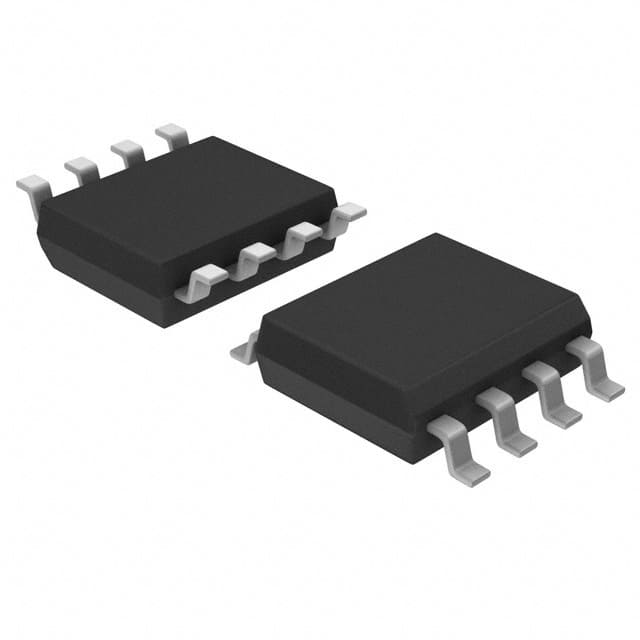Lihat spesifikasi untuk detail produk.

X9C104SIZ
Product Overview
- Category: Integrated Circuit (IC)
- Use: Digital Potentiometer
- Characteristics: Non-volatile, 100 taps, 10kΩ resistance range
- Package: SOIC-8
- Essence: Adjustable resistor with digital control
- Packaging/Quantity: Tape and Reel, 2500 units per reel
Specifications
- Resistance Range: 10kΩ
- Number of Taps: 100
- End-to-End Resistance Tolerance: ±20%
- Supply Voltage: 2.7V to 5.5V
- Operating Temperature Range: -40°C to +85°C
- Interface: Serial, 3-wire
Detailed Pin Configuration
The X9C104SIZ has a total of 8 pins in the SOIC-8 package:
- VCC: Supply voltage input
- H: High terminal of the resistor element
- U/D: Up/Down control input
- CS: Chip select input
- INC: Increment control input
- W: Wiper terminal of the resistor element
- GND: Ground reference
- L: Low terminal of the resistor element
Functional Features
- Non-volatile memory: Retains wiper position even when power is removed
- Digital control: Allows precise adjustment of resistance value
- Increment/Decrement control: Provides easy adjustment in both directions
- Serial interface: Simple communication with microcontrollers or other devices
- Low power consumption: Suitable for battery-powered applications
Advantages and Disadvantages
Advantages: - Non-volatile memory ensures settings are retained - Precise digital control allows fine adjustments - Easy integration with microcontrollers - Low power consumption extends battery life
Disadvantages: - Limited resistance range (10kΩ) - End-to-end resistance tolerance of ±20% may not be suitable for high-precision applications
Working Principles
The X9C104SIZ is a digital potentiometer that replaces traditional mechanical potentiometers. It consists of a resistor network and a wiper that can be digitally controlled. The resistance value between the wiper terminal and either end terminal can be adjusted by sending appropriate control signals through the serial interface.
When the U/D (Up/Down) control input receives an increment signal, the wiper moves towards the H (High) terminal, increasing the resistance. Conversely, a decrement signal moves the wiper towards the L (Low) terminal, decreasing the resistance. The current wiper position is stored in non-volatile memory, ensuring it is retained even when power is removed.
Detailed Application Field Plans
The X9C104SIZ finds applications in various fields, including:
- Audio Equipment: Volume control, tone adjustment
- Industrial Automation: Calibration, fine-tuning
- Test and Measurement Instruments: Resistance simulation, calibration
- Automotive Electronics: Climate control, lighting intensity adjustment
- Consumer Electronics: Display brightness control, user interface settings
Alternative Models
Other digital potentiometers that can be considered as alternatives to the X9C104SIZ include:
- MCP41010: 10kΩ, 256 taps, SPI interface
- AD8400: 10kΩ, 256 taps, I2C interface
- MAX5486: 10kΩ, 256 taps, SPI interface
These models offer similar functionality but may have different specifications or package options.
In conclusion, the X9C104SIZ is a versatile digital potentiometer with non-volatile memory, precise digital control, and a wide range of applications. Its compact package and ease of integration make it suitable for various electronic systems requiring adjustable resistance.
Sebutkan 10 pertanyaan dan jawaban umum terkait penerapan X9C104SIZ dalam solusi teknis
Sure! Here are 10 common questions and answers related to the application of X9C104SIZ in technical solutions:
Q: What is X9C104SIZ? A: X9C104SIZ is a digitally controlled potentiometer, also known as a digital potentiometer, which can be used to vary resistance electronically.
Q: What is the purpose of using X9C104SIZ in technical solutions? A: X9C104SIZ can be used to replace traditional mechanical potentiometers in various applications, providing precise and reliable control over resistance values.
Q: How does X9C104SIZ work? A: X9C104SIZ consists of a series of resistive elements and switches that can be controlled digitally. By toggling these switches, the resistance value across the device can be adjusted.
Q: What are the key features of X9C104SIZ? A: Some key features of X9C104SIZ include non-volatile memory, low power consumption, wide operating voltage range, and small package size.
Q: In what applications can X9C104SIZ be used? A: X9C104SIZ can be used in audio equipment, instrumentation, industrial control systems, automotive electronics, and other applications where precise resistance control is required.
Q: How do I interface with X9C104SIZ? A: X9C104SIZ can be controlled using a microcontroller or any other digital circuitry. It typically uses a serial interface (such as SPI or I2C) for communication.
Q: Can X9C104SIZ be used as a variable resistor? A: Yes, X9C104SIZ can be used as a variable resistor by adjusting the digital control inputs to change the resistance value.
Q: Is X9C104SIZ suitable for high-speed applications? A: No, X9C104SIZ is not designed for high-speed applications. It is more commonly used in low to moderate speed applications.
Q: Can X9C104SIZ withstand high voltages? A: X9C104SIZ has a maximum operating voltage of typically around 5V, so it is not suitable for high-voltage applications.
Q: Are there any limitations or considerations when using X9C104SIZ? A: Some considerations include limited resolution (typically 100 steps), limited current handling capability, and the need for proper decoupling and protection circuitry.
Please note that these answers are general and may vary depending on specific datasheet specifications and application requirements.

